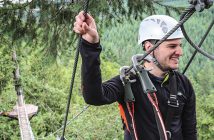Both systems keep the participant connected at all times, can be used by children and allow for easy overtaking. Once it is attached to the lifeline, the trolley can only be removed at the end of the course by staff. The smooth-rolling trolley provides easy, convenient passage for guests of all ages, even when the belay is out of reach. The Speedrunner can be complemented with additional accessories to accommodate a variety of design possibilities.
Both systems both have an intermediate bracket to offer redundant safety, and, because they are designed to be simple to set and take apart, the products can be reused, maintained and easily inspected throughout the year without interrupting their use. “The Saferoller and Speedrunner systems adopt the philosophy that the client can revise and maintain the product on his own,” says Jacques Christinet, CTO of Kanopeo. The frequent use of long zip lines (1,000 to 1,350 feet) led Kanopeo to offer a braking solution for safe use.
The CouDou Pro system has been adapted for the North American market. The system uses a carabiner without a moving gate, which slides onto the belay line, and stainless steel plates that connect from one element to the next.
The critical element of the CouDou Pro system is the ZAZA2 CS connector. Once on, it will only slide off the lifeline at one end or the other, preventing accidental disconnection. “It’s independent in the sense that the participant is hooking themselves up to the system and unhooking at the end, so they don’t have an opportunity to make a mistake in the middle,” says Kenny Brodin, manager of technical sales at Kong USA, distributor of the CouDou Pro system.
Accessories adapt the system for a variety of purposes. CouDou Pro’s ANSV system allows mid-course swings and elevation changes, while the PAIG plate allows a course to split. New for 2015 are the ZAZA2 PBJ (for lifelines up to 170 feet and zip lines up to 275 feet) and ZAZA2 PBT plates (for zip lines from 275-1,000 feet), which both connect to the wire using a quick-link, greatly reducing the cost to install. The new ZAZA2 STOP prevents guests from sliding backward down a sloped element and acts as a fender to prevent metal-to-metal impacts between the Kong ZIP EVO trolley and the CouDou Pro endplates.
The Koala Equipment Continuous Belay System is fully integrated. The Pouliz 2.0 pulley rides on a continuous belay line and allows customers to move from one obstacle to another, including zip lines up to 1,650 feet long and vertical activities, without having to manipulate any carabiners. Guests are connected via a double asymmetrical lanyard.
The system “is the result of four years of research and development based on our vast experience both in construction, as we have built over 180 ropes courses in 18 years, and in operating courses, as we have been running our own high ropes course since 1997,” says Laurent Comte, sales director for Koala.
Koala Equipment’s continuous belay system is easy to install on new or existing courses either on trees or on artificial supports. It can be attached onto the supports in 3 different ways: with double brackets and bolts; with metal straps and a connecting part, ideal for children’s courses as it provides higher stability on the obstacles; or with wire rope slings and Maillon Rapide quick links, the least expensive option, also suited to install the lifeline off-center.
A shuttle device, The Switch, is used to transfer the Pouliz trolley to vertical activities such as climbing walls, Tarzan swings, Quick Jumps and Power Fans while maintaining continuous belay.
Roperoller is a continuous belay system made in Germany. It’s certified by DEKRA, a German inspection institute that tests and certifies the safety and quality of manufactured goods. The roperoller mounting parts allow the cable to move up and down freely, to avoid wire breakage caused by material fatigue. It’s adaptable to a variety of supports, using bolts for poles and concrete structures, clamp connections for steel beams, and steel or synthetic tension belts for attaching to trees.
The shuttle is the central element of the roperoller system. It can be fitted with either bush bearing or ball bearing cable rollers made of hardened stainless steel to regulate the shuttle’s freedom of motion; choice of bearings also allows construction of zip lines with different angles and lengths.
The shuttle has a simple opening mechanism that can be closed by either a triple-lock carabiner or a rapid link. Participants are attached to the shuttle via an adjustable lanyard.





